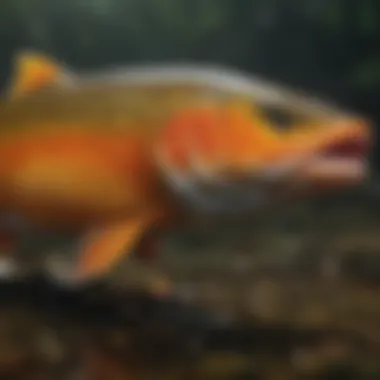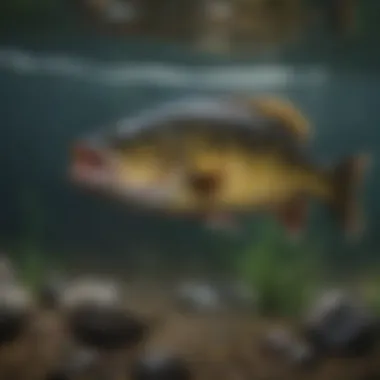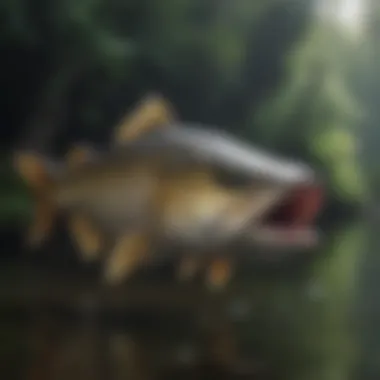Discovering the Diverse Aquatic Life of West Virginia's Waterways


Animal Species Profile
West Virginia, a state blessed with diverse water bodies, is home to a wide array of fish species. These fish, both native and introduced, exhibit unique characteristics and adaptations, enriching the aquatic ecosystems of the region. Exploring the types of fish in West Virginia provides valuable insights into the rich biodiversity of its waterways and stresses the significance of conservation efforts to ensure the survival of these precious species.
- Physical Characteristics and Appearance
West Virginia's fish species showcase a range of physical characteristics and appearances, varying from sleek, silver bodies to vibrant hues or intricate patterns. Some species may have streamlined forms suited for swift swimming, while others exhibit distinct features like whisker-like barbels or elaborate fins that serve specific purposes in their natural environments.
- Natural Habitat and Distribution
The fish in West Virginia inhabit a spectrum of aquatic environments, from gushing mountain streams to serene lakes or reservoirs. Each species has its preferred habitat, with some thriving in clear, cold waters, while others may be found in muddy or vegetated areas. Understanding the distribution of these fish sheds light on the interconnectedness of West Virginia's aquatic ecosystems.
- Behavior and Social Interactions
Observing fish behavior reveals fascinating insights into their social interactions and survival strategies. Some species may exhibit schooling behavior for protection, while others engage in territorial displays or intricate mating rituals. Exploring how fish interact with one another provides a glimpse into the dynamics of their underwater communities and ecological roles within their habitats.
Introduction
In this comprehensive article, we embark on a fascinating journey into the realm of fish species that inhabit the diverse waterways of West Virginia. By delving into both native and introduced varieties, we aim to unravel the intricacies of the region's aquatic ecosystems, shedding light on the unique characteristics and adaptations of each species. Through this exploration, we not only enhance our understanding of West Virginia's aquatic biodiversity but also emphasize the crucial need for conservation efforts to safeguard these valuable aquatic inhabitants.
Overview of West Virginia's Aquatic Ecosystems
The Allegheny Plateau Region
The Allegheny Plateau Region stands out as a prominent contributor to West Virginia's aquatic biodiversity. With its rich mix of rivers, streams, and lakes, this region serves as a vital habitat for various fish species, each adapted to its unique aquatic landscape. Its significant ecological value lies in its diverse range of habitats, fostering the sustenance of a wide array of fish species. While its rugged terrain poses challenges, it also provides opportunities for fish diversity to flourish, making it a focal point in our exploration of West Virginia's aquatic ecosystems.
The Ohio River Basin
The Ohio River Basin plays a pivotal role in shaping West Virginia's aquatic ecosystems. Spanning across multiple states, this basin encompasses a vast network of waterways that support diverse fish populations. One of its key characteristics is the interconnectivity it offers between various aquatic habitats, facilitating the movement of fish species and promoting genetic diversity. Despite facing environmental pressures, the Ohio River Basin remains a crucial site for understanding the dynamic interactions between fish populations and their surrounding environment.
The Eastern Panhandle Waters
The Eastern Panhandle Waters represents a unique aquatic environment within West Virginia. Characterized by its mountainous terrain and pristine streams, this region harbors specialized fish species adapted to its cold, clear waters. The key allure of this area lies in its unspoiled beauty and the presence of rare fish species that have evolved to thrive in its distinct ecological niche. While conservation efforts are imperative to preserve its fragile ecosystems, the Eastern Panhandle Waters offer invaluable insights into the resilience and adaptability of fish species in response to environmental challenges.
Importance of Fish Diversity


Ecological Significance
The ecological significance of fish diversity cannot be overstated in the context of West Virginia's aquatic ecosystems. Fish serve as integral components of these habitats, contributing to nutrient cycles, energy transfer, and overall ecosystem stability. By examining the intricate interactions between fish species and their environment, we gain a deeper appreciation for the crucial role they play in maintaining ecological balance. Understanding the ecological significance of fish diversity enables us to implement effective conservation strategies that uphold the delicate equilibrium of West Virginia's aquatic ecosystems.
Economic Impact
Fish diversity in West Virginia exerts a substantial economic influence on various sectors, including recreational fishing, tourism, and commercial fisheries. The presence of diverse fish species not only attracts anglers and nature enthusiasts but also supports local economies through revenue generation and employment opportunities. By quantifying the economic benefits associated with fish diversity, we highlight the tangible value of conserving these aquatic resources for sustainable use and long-term prosperity.
Cultural Importance
Fish have held profound cultural significance in West Virginia's heritage, manifesting in traditions, folklore, and culinary practices. The cultural importance of fish diversity transcends mere sustenance, encompassing spiritual connections, artistic representations, and community rituals. By exploring the cultural significance of fish in West Virginia, we tap into a heritage deeply intertwined with the natural world, fostering a sense of identity and belonging rooted in the region's aquatic treasures.
Native Fish Species
In this article, the focus lies on the paramount significance of Native Fish Species within West Virginia's aquatic ecosystems. These indigenous fish species play a crucial role in maintaining the ecological balance of the waterways. Their presence is not merely a reflection of biodiversity but also acts as indicators of overall ecosystem health. Understanding and preserving these native species are essential for ensuring the sustainability and resilience of the aquatic environment.
Brook Trout
Habitat and Distribution
The Habitat and Distribution of Brook Trout are fundamental aspects that contribute significantly to the understanding of this species within West Virginia. Brook Trout are typically found in clear, cold, and highly oxygenated streams, making them a vital component of freshwater ecosystems. Their preference for pristine environments underscores the importance of conserving natural habitats to sustain their populations. Restoring and preserving stream habitats are key to ensuring the long-term survival of this iconic fish species.
Characteristics and Behavior
Exploring the Characteristics and Behavior of Brook Trout provides valuable insights into the adaptations and life cycle of these fish. Known for their vibrant colors and distinct markings, Brook Trout exhibit unique behavioral patterns such as territoriality and spawning behavior. Their feeding habits and reproductive strategies further highlight their significance in West Virginia's freshwater systems. Studying these characteristics aids in formulating effective conservation strategies to protect and enhance Brook Trout populations.
Conservation Status
The Conservation Status of Brook Trout serves as a pivotal indicator of the challenges facing native fish species in West Virginia. Due to various environmental stressors, including habitat degradation and competition from introduced species, Brook Trout populations have faced decline in certain areas. Conservation efforts focusing on habitat restoration, pollution control, and sustainable angling practices are crucial in mitigating these threats and promoting the long-term viability of Brook Trout populations.
Introduced Fish Species
Rainbow Trout
Introduction and Establishment
Rainbow Trout, a well-known introduced species in West Virginia, have established themselves in various water bodies across the state. Their introduction into the region has led to both positive and negative ramifications for the local ecosystem. The adaptability of Rainbow Trout to different environmental conditions has made them a popular choice for stocking programs, enhancing fishing opportunities for anglers. However, their tendency to outcompete native fish for resources raises concerns about biodiversity conservation.


Impact on Native Ecosystems
The presence of Rainbow Trout in West Virginia's waterways has had a notable impact on native fish populations. Their competitive nature and voracious feeding habits can disrupt the delicate balance within aquatic habitats, potentially leading to a decline in indigenous species. Understanding the interactions between Rainbow Trout and native fish is crucial for implementing effective management strategies to mitigate their impact on the ecosystem.
Human Interactions
Human interactions with Rainbow Trout reflect a complex relationship centered around recreational fishing and conservation efforts. Anglers are drawn to the challenge of catching Rainbow Trout due to their elusive nature and fighting spirit, contributing to the popularity of these introduced fish. However, sustainable fishing practices and regulations are essential to prevent overexploitation and maintain the ecological equilibrium of West Virginia's water bodies.
Blue Catfish
Growth and Reproduction
Blue Catfish, introduced to West Virginia for recreational fishing purposes, have exhibited rapid growth rates and robust reproductive capabilities. Their ability to thrive in various aquatic environments has made them a sought-after species among anglers, providing an exciting fishing experience. Despite their popularity, concerns arise regarding their potential impact on native fish populations and ecosystem dynamics.
Management Challenges
The management of Blue Catfish poses challenges related to population control and conservation strategies. Balancing the demand for recreational harvest with the preservation of native fish species requires careful planning and regulatory interventions. Addressing the management challenges associated with Blue Catfish necessitates a collaborative approach involving policymakers, scientists, and the angling community.
Recreational Harvest
Recreational harvest of Blue Catfish offers fishing enthusiasts an opportunity to engage with this species while enjoying the thrill of the catch. However, sustainable harvest practices are essential to ensure a responsible approach to fishing activities. Monitoring recreational harvest levels and implementing catch limits can help maintain healthy Blue Catfish populations and support long-term conservation efforts.
Flathead Catfish
Behavioral Traits
Flathead Catfish, characterized by their unique behaviors such as nocturnal feeding habits and solitary nature, present a fascinating study in fish ecology. Their preference for deep, slow-moving waters makes them challenging to capture, adding to their allure for anglers seeking a rewarding fishing experience. Understanding the behavioral traits of Flathead Catfish is essential for conservation initiatives aiming to protect their habitats.
Feeding Preferences
Flathead Catfish exhibit specific feeding preferences, primarily targeting live prey such as smaller fish, crustaceans, and aquatic insects. This dietary selectivity influences their role in the food web and ecological dynamics of West Virginia's water bodies. Monitoring and analyzing the feeding preferences of Flathead Catfish contribute to the formulation of sustainable management practices and habitat conservation strategies.
Conservation Concerns
The conservation concerns associated with Flathead Catfish revolve around habitat degradation, overfishing, and invasive species interactions. Protecting the natural habitats of Flathead Catfish, mitigating the effects of human impacts, and addressing conservation challenges are vital for safeguarding the long-term viability of this species. Collaborative efforts among stakeholders are essential to ensure the conservation of Flathead Catfish populations and the preservation of West Virginia's aquatic biodiversity.
Conservation Efforts


Habitat Restoration Projects
Stream Bank Stabilization
Stream Bank Stabilization is a fundamental aspect of habitat restoration projects designed to protect the integrity of stream banks and prevent erosion. By implementing techniques such as using natural elements like rocks or vegetation to fortify the banks, this practice helps maintain water quality, prevents sediment buildup, and creates stable habitats for fish reproduction and growth. Its significance lies in enhancing the resilience of stream ecosystems against disturbances and providing essential shelter and food sources for aquatic species.
Wetland Protection
Wetland Protection focuses on preserving the critical habitats that offer shelter, breeding grounds, and feeding areas for various fish species. By safeguarding wetlands from encroachment and pollution, conservationists ensure the integrity of these unique ecosystems, supporting a diverse array of flora and fauna. The restoration and protection of wetlands contribute to enhancing water quality, regulating water flow, and promoting biodiversity, making them invaluable for the conservation of fish populations in West Virginia.
Fish Passage Improvement
Fish Passage Improvement initiatives aim to enhance the connectivity of water bodies, ensuring that fish can migrate between different habitats for breeding, feeding, and seeking refuge. By removing barriers like dams or culverts and creating fish passages, these projects facilitate the movement of fish species, restoring their natural migration patterns and promoting genetic diversity. This approach not only benefits fish populations but also improves overall ecosystem health by allowing for the exchange of nutrients and energy flow among different aquatic habitats.
Regulatory Policies
Regulatory Policies pertaining to fishing activities play a critical role in supporting conservation efforts and managing fish populations sustainably. Fishing Regulations establish guidelines on allowable catch limits, size restrictions, and fishing seasons to prevent overexploitation of fish stocks, ensuring their long-term viability. These policies help maintain ecological balance, prevent the depletion of fish resources, and support the recreational and commercial fishing sectors in a sustainable manner.
Invasive Species Management
Invasive Species Management strategies focus on controlling and eradicating non-native species that pose a threat to native fish populations and ecosystems. By monitoring and implementing measures to prevent the spread of invasive species, conservationists protect the biodiversity of aquatic environments and minimize the competition for resources among different fish species. Effective management of invasive species plays a vital role in preserving the native flora and fauna, maintaining ecosystem stability, and promoting the resilience of West Virginia's aquatic ecosystems.
Water Quality Monitoring
Water Quality Monitoring is essential for assessing the health of aquatic ecosystems and ensuring the well-being of fish populations in West Virginia. By monitoring parameters such as oxygen levels, p H, and nutrient concentrations, experts can detect pollution sources, track changes in water quality, and implement measures to mitigate adverse effects on fish habitats. Regular monitoring helps conservationists identify potential threats to aquatic biodiversity, protect water resources, and maintain the ecological balance necessary for the survival of the diverse fish species inhabiting the region.
Conclusion
In summarizing the exploration of the diverse types of fish in West Virginia, it becomes evident that safeguarding the aquatic ecosystems is pivotal for maintaining biodiversity and ecological balance. Understanding the interplay between conservation efforts and recreational activities is crucial for long-term sustainability. By appreciating the delicate equilibrium required to preserve these fish species, we acknowledge the significant role each one plays in the overall health of the region. Without proactive measures, the rich tapestry of West Virginia's fish diversity may face unforeseen challenges.
Appreciating West Virginia's Fish Diversity
Balancing Conservation and Recreation
Delving into the intricacies of balancing conservation with recreational pursuits uncovers a nuanced relationship essential for preserving fish populations. Striking the right balance ensures that while enthusiasts enjoy fishing experiences, the native fish species are not unduly compromised. This equilibrium serves as a foundational principle in managing aquatic resources sustainably. Balancing conservation and recreation promotes a harmonious coexistence between human activities and the natural environment, fostering mutual respect and responsible stewardship.
Promoting Environmental Awareness
Promoting environmental awareness is a key factor in nurturing a culture of conservation among local communities and beyond. Creating a sense of environmental stewardship instills a deeper appreciation for the intricate connections within aquatic ecosystems. By highlighting the importance of preserving these habitats, individuals are motivated to take proactive steps in safeguarding fish diversity. Environmental awareness campaigns enhance public consciousness and participation, reinforcing the value of sustainable practices in safeguarding West Virginia's aquatic treasures.
Sustaining Aquatic Biodiversity
The sustainability of aquatic biodiversity hinges on concerted efforts to protect vulnerable fish species and their habitats. Sustaining aquatic biodiversity involves not only addressing immediate threats but also implementing long-term strategies for resilience. By prioritizing the conservation of diverse fish populations, West Virginia ensures the resilience of its aquatic ecosystems for future generations. The multifaceted approach to sustaining aquatic biodiversity integrates scientific research, policy development, and community engagement, laying a robust foundation for enduring ecological health and vitality.







